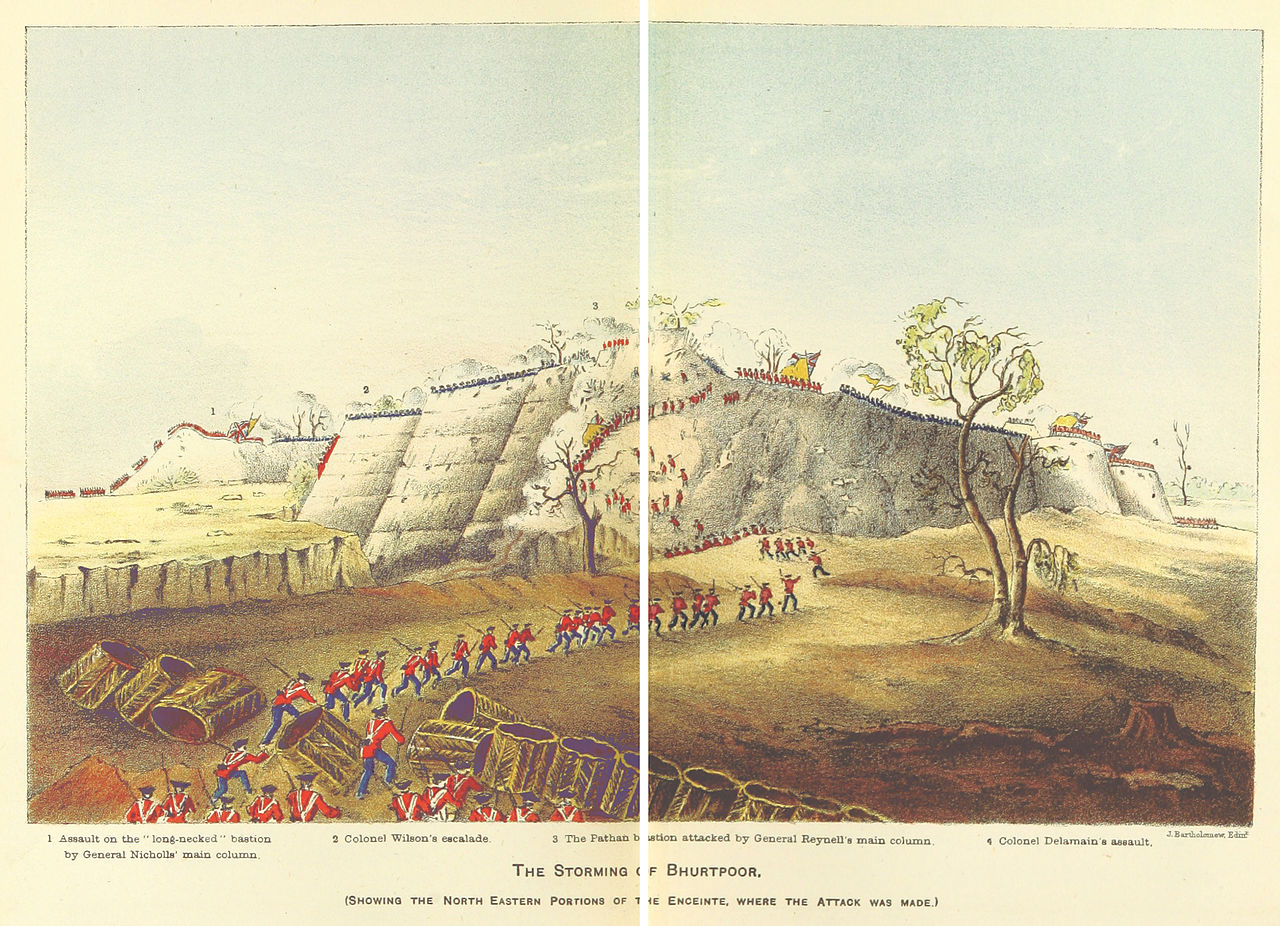The Siege of Bharatpore was a siege that took place in the Indian princely state of Bharatpur (now part of Rajasthan) between December 1825 and January 1826. British troops under Lord Combermere initially surrounded the state’s capital until on 18 January 1826 its fortress was stormed and captured.
Date :- 9 December 1825 – 18 January 1826
Location :- Bharatpur, Rajasthan
Fifty-five kilometres west of Agra, on the edge of Rajasthan, Bharatpur is, for India, a medium-sized city, the centre of an agricultural region, and in its centre stand a collection of government offices and museums called the Lohagarh Fort. Just under two hundred years ago, however, Bhurtpore (as it was spelt) was the capital of the Bharatpur Kingdom, its fortress had a reputation for being impregnable, and among those looking up at its cliffs and walls was a young engineering officer, a Yorkshire man from the edge of the Dales called Joseph Tindal.
It was December, 1825, and Tindal was there because in February of that year the Raja, Baldeo Singh, had died. He was succeeded by his six year-old son, Bulwant Singh, supported by a regent agreed with and approved by the British – but the new king’s cousin, Durgan Sal, had other ideas. At the end of March Durgan usurped the throne. The British Resident in Delhi, Sir David Ocherlony, warned the local people and chieftains not to support Durgan, but he was ignored.
Durgan and his followers had two reasons for confidence: the British were already committed to a war in Burma, and the Jats calculated that that meant there would not be sufficient troops left over to fight them; moreover, there was a belief that the fortress in Bhurtpore was impregnable, famed for an episode twenty years previously when it had withstood a siege and several assaults by a British army under General Lake. The British had suffered very few military setbacks in India, so Bhurtpore assumed a symbolic significance for the independent princes of North India. As James Creighton recounted in his memoir of the coming conflict, all of Northern India was watching Bhurtpore, and if Durgan Sal succeeded in his defiance then “not a chieftain who could muster one hundred followers but would have brought them against us”. Action had to be taken.
In July 1825 Ochter lony died, and was replaced by Sir Charles Metcalf , who had been General Lake’s political assistant twenty years earlier. Metcalf called on Viscount Combermere, who as General Stapleton Cotton had previously commanded the cavalry in the Peninsular War, and dispatched him to Bhurtpore with twenty-seven thousand men.
Joseph Tindal was with those troops, one of several officers from the Bengal Engineers. He was the son and grandson of Skipton attorneys, with two elder brothers who had also gone into the law (one becoming a barrister at The Inns of Court), but Joseph must have been tempted by the potential glamour, excitement and potential for wealth that lay in India. At Bhurtpore Combermere needed the engineers to prepare siege trenches and to create the mine galleries with which he intended to bring down the fort’s walls. Tindal would have work to do.
The Siege :-
The campaign started well for the British. They arrived on December 10th, and almost immediately secured the Jheel Bund, the earth wall surrounding the city’s lake, which if breached would have flooded the fort’s outer defensive ditches and the surrounding countryside, thus making Combermere’s task even more difficult. Taking advantage of this success the British went on over the next two weeks to secure a number of local villages, as well as an area of ground known as Maharaja Baldeo Singh’s Garden, and proceeded to construct redoubts in preparation for a siege. Trenches were dug to connect the strong points, and guns and mortars positioned. It was not all uneventful, as cannons were firing from the fort, and there were a number of skirmishes involving Jat cavalry, who were stationed in the jungle outside the fort.
On Christmas Eve the British guns opened fire (Christmas was not forgotten; the troops received a double ration of liquor on the 25th), and the pattern for the next week was established. The British guns pounded the fort’s east wall and gates. The Jat artillery responded with some accuracy, apparently directed by a renegade artilleryman named Herbert, who had noted the positions of the British guns before deserting. Despite the enemy fire more advanced batteries were established, with sustained fire on the fort’s north-east angle, and also onto its west face. Then on January 1st a mine gallery was begun, directed at that north-east corner, and it was then that the first officer fatality of the campaign was suffered. Combermere wrote to Metcalf, “I regret I have to report the death of First-Lieutenant Tindal, a promising young engineering officer”. Joseph had been working in the trenches when he was hit by a cannon-shot.
For another 17 days the siege continued. The artillery persevered, the Jats attempted various sorties which were repulsed, and mines were laid by both sides. On January 4th breaches in the walls were apparent, and storming parties were organized, but the breaches were deemed impracticable, and so the mining and cannonades continued.
The Attack :-
On the 18th the attack finally began. At 8.30 a large mine was exploded under the north-east angle, and that was the signal for a concerted assault on two breaches and a gate. It was surprisingly easy. Within an hour the British troops had penetrated the walls, and by four in the afternoon the garrison had surrendered, with Durgan Sal captured as he tried to flee the city. Maharaja Balwant Singh was restored to the throne, and the British had secured their influence over the Jats, destroying the myth of Bhurtpore’s impregnability in the process. The deserter Herbert did not get away. He was caught and hanged.
Sources and References :-
- British small forgotten wars
- “The Siege of Bhurtpore 1825”. The Museum of the King’s Royal Hussars. 7 January 2015. Retrieved 4 December 2015
- Murray 1878, p. 486
- Stapleton Cotton, Stapleton Cotton & Knollys 1866, p. 30
- Creighton 1830, p. 10-100
- Viscount Combermere”. The Daily Telegraph. 16 November 2000. Retrieved 1 December 2015
Bibliography :-
- Blackwoods (1828). Blackwood’s Edinburgh Magazine. William Blackwood & Sons.
- Burke, Bernard (1869). A Genealogical and Heraldic Dictionary of the Peerage and Baronetage of the British Empire. London: Harrison.
- Creighton, James Norman (1830). Narrative of the siege and capture of Bhurtpore, in the province of Agra, upper Hindoostan, by the forces under the command of Lord Combermere, in the latter end of 1825, and beginning of 1826. London.
- Stapleton Cotton, Mary Woolley; Stapleton Cotton, Stapleton; Knollys, William Wallingford (1866). Memoirs and Correspondence of Field-marshal Viscount Combermere, from his family papers, by Mary Viscountess Combermere and W.W. Knollys.
- Grant, James (1885). British battles on land and sea.
- Murray, John (1878). Handbook for England and Wales: Alphabetically Arranged for the Use of Travellers … J. Murray.


